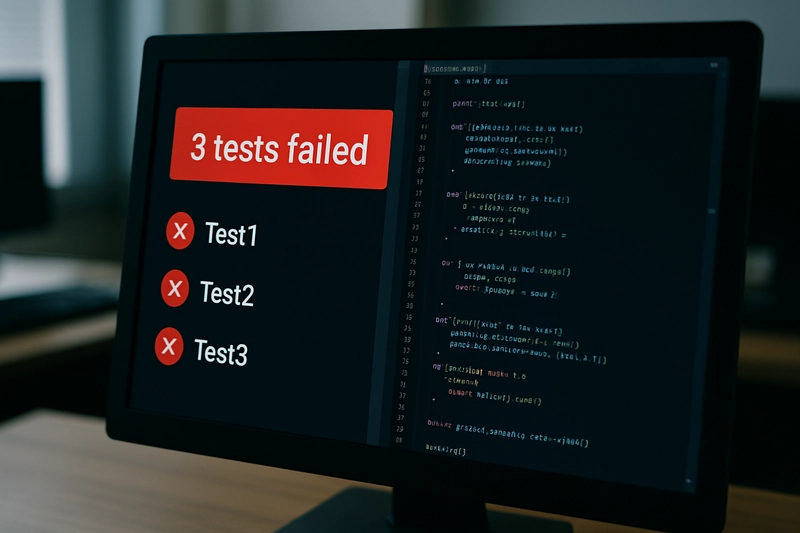From Flaky Tests to Security Threats: Where Quality Overlaps with Risk
It usually starts small. An automated test fails. You shrug it off. Maybe it’s a timing issue. Maybe the network hiccupped. You rerun it, and everything passes. No harm, no foul. Except — what if that little flaky test was actually trying to tell you something bigger? These days, the line between a harmless bug and a full-blown security threat isn’t just blurry — it’s almost invisible. And if you’re still thinking of quality and risk as two separate things, you might already be falling behind. When Flaky Means Fragile If you’ve worked in software for more than five minutes, you know the drill: • The test fails once. • Passes on retry. • Gets marked as “flaky.” • Nobody loses sleep over it. But here’s the thing nobody talks about enough: flaky tests aren’t just annoying. They’re often early warning signs of deeper instability. • A race condition here. • A bad timeout there. • Some unpredictable behavior when systems are under load. Sure, sometimes a flaky test really is harmless. But sometimes? It’s a crack in the foundation that’s just waiting for someone (or something) to pry it open. Attackers don’t care if your UI is pretty. They care if your system is fragile. And flaky tests? They’re practically a neon sign flashing “fragile.” Quality and Security: Two Sides of the Same Coin For a long time, teams treated “quality” and “security” like two different planets. QA teams checked if stuff worked. Security teams checked if stuff could be broken. But in real life? It’s all the same thing. A validation bug that lets users upload weird file types? • It’s not just a quality issue. It’s a potential malware gateway. A broken logout button? • It’s not just annoying. It’s a session hijack waiting to happen. A weird timeout that nobody can consistently reproduce? • Maybe it’s nothing… or maybe it’s the doorway to a denial-of-service attack. The old walls between QA and Security don’t hold up anymore. If something’s broken, unstable, or unpredictable — it’s not just a quality problem. It’s a risk. And treating it like anything less is playing with fire. A Shift in Mindset: Testing Is Risk Management Now QA used to be about finding bugs early so we didn’t ship broken stuff. That’s still true. But now, it’s also about spotting the cracks that bad actors could sneak through later. When a tester digs into a flaky login test, they’re not just being picky — they’re protecting user accounts. When someone questions a weird edge case flow, they’re doing the same thing hackers would: poking at the seams. Testing isn’t just about validation anymore. It’s about resilience. It’s about trust. It’s about keeping promises we make — not just to our users, but to our future selves. So What Can Teams Actually Do? If you’re nodding along but wondering, “Okay, how do we actually work differently?”, here’s what’s working out there: • Teach QA teams the basics of security. You don’t need everyone to be a white-hat hacker. But everyone should know what an insecure direct object reference (IDOR) is, or why CSRF tokens matter. • Blend security tests into your pipelines. Security scans shouldn’t be an afterthought. Make them as normal as unit tests. • Prioritize risky areas. Not all bugs are created equal. Some glitches are harmless. Others could bring down everything. Learn to tell the difference — and chase the right ones harder. • Talk to each other. QA, security, devs — you’re all on the same team. Meet regularly. Share what you’re seeing. Swap horror stories. You’ll be surprised how much you learn. • Treat unpredictability seriously. If something behaves weirdly sometimes? Don’t just shrug and rerun. Investigate. Flakiness is trying to tell you a story. Listen. Where This Is All Heading At the end of the day, nobody downloads an app thinking, “I really hope this isn’t riddled with vulnerabilities.” They trust you. They trust that when they hit “Sign up” or “Pay now” or “Upload file,” things will just work. And they trust that their data — their lives — won’t be hanging by a thread because of a missed flaky test. Quality and security aren’t separate anymore. They never really were. Both are about building things people can rely on. Both are about protecting what matters. And both start with us — noticing when something isn’t quite right, even when it’s easier to look away.

It usually starts small.
An automated test fails. You shrug it off. Maybe it’s a timing issue. Maybe the network hiccupped. You rerun it, and everything passes. No harm, no foul.
Except — what if that little flaky test was actually trying to tell you something bigger?
These days, the line between a harmless bug and a full-blown security threat isn’t just blurry — it’s almost invisible.
And if you’re still thinking of quality and risk as two separate things, you might already be falling behind.
When Flaky Means Fragile
If you’ve worked in software for more than five minutes, you know the drill:
• The test fails once.
• Passes on retry.
• Gets marked as “flaky.”
• Nobody loses sleep over it.
But here’s the thing nobody talks about enough: flaky tests aren’t just annoying. They’re often early warning signs of deeper instability.
• A race condition here.
• A bad timeout there.
• Some unpredictable behavior when systems are under load.
Sure, sometimes a flaky test really is harmless.
But sometimes? It’s a crack in the foundation that’s just waiting for someone (or something) to pry it open.
Attackers don’t care if your UI is pretty. They care if your system is fragile.
And flaky tests? They’re practically a neon sign flashing “fragile.”
Quality and Security: Two Sides of the Same Coin
For a long time, teams treated “quality” and “security” like two different planets.
QA teams checked if stuff worked.
Security teams checked if stuff could be broken.
But in real life?
It’s all the same thing.
A validation bug that lets users upload weird file types?
• It’s not just a quality issue. It’s a potential malware gateway.
A broken logout button?
• It’s not just annoying. It’s a session hijack waiting to happen.
A weird timeout that nobody can consistently reproduce?
• Maybe it’s nothing… or maybe it’s the doorway to a denial-of-service attack.
The old walls between QA and Security don’t hold up anymore.
If something’s broken, unstable, or unpredictable — it’s not just a quality problem. It’s a risk.
And treating it like anything less is playing with fire.
A Shift in Mindset: Testing Is Risk Management Now
QA used to be about finding bugs early so we didn’t ship broken stuff.
That’s still true.
But now, it’s also about spotting the cracks that bad actors could sneak through later.
When a tester digs into a flaky login test, they’re not just being picky — they’re protecting user accounts.
When someone questions a weird edge case flow, they’re doing the same thing hackers would: poking at the seams.
Testing isn’t just about validation anymore. It’s about resilience.
It’s about trust.
It’s about keeping promises we make — not just to our users, but to our future selves.
So What Can Teams Actually Do?
If you’re nodding along but wondering, “Okay, how do we actually work differently?”, here’s what’s working out there:
• Teach QA teams the basics of security. You don’t need everyone to be a white-hat hacker. But everyone should know what an insecure direct object reference (IDOR) is, or why CSRF tokens matter.
• Blend security tests into your pipelines. Security scans shouldn’t be an afterthought. Make them as normal as unit tests.
• Prioritize risky areas. Not all bugs are created equal. Some glitches are harmless. Others could bring down everything. Learn to tell the difference — and chase the right ones harder.
• Talk to each other. QA, security, devs — you’re all on the same team. Meet regularly. Share what you’re seeing. Swap horror stories. You’ll be surprised how much you learn.
• Treat unpredictability seriously. If something behaves weirdly sometimes? Don’t just shrug and rerun. Investigate. Flakiness is trying to tell you a story. Listen.
Where This Is All Heading
At the end of the day, nobody downloads an app thinking, “I really hope this isn’t riddled with vulnerabilities.”
They trust you.
They trust that when they hit “Sign up” or “Pay now” or “Upload file,” things will just work.
And they trust that their data — their lives — won’t be hanging by a thread because of a missed flaky test.
Quality and security aren’t separate anymore. They never really were.
Both are about building things people can rely on.
Both are about protecting what matters.
And both start with us — noticing when something isn’t quite right, even when it’s easier to look away.


































































































































































![[The AI Show Episode 143]: ChatGPT Revenue Surge, New AGI Timelines, Amazon’s AI Agent, Claude for Education, Model Context Protocol & LLMs Pass the Turing Test](https://www.marketingaiinstitute.com/hubfs/ep%20143%20cover.png)






























































































































![[DEALS] Koofr Cloud Storage: Lifetime Subscription (1TB) (80% off) & Other Deals Up To 98% Off – Offers End Soon!](https://www.javacodegeeks.com/wp-content/uploads/2012/12/jcg-logo.jpg)






















![Is this too much for a modular monolith system? [closed]](https://i.sstatic.net/pYL1nsfg.png)



















































































































_roibu_Alamy.jpg?width=1280&auto=webp&quality=80&disable=upscale#)














































































































![M4 MacBook Air Drops to Just $849 - Act Fast! [Lowest Price Ever]](https://www.iclarified.com/images/news/97140/97140/97140-640.jpg)
![Apple Smart Glasses Not Close to Being Ready as Meta Targets 2025 [Gurman]](https://www.iclarified.com/images/news/97139/97139/97139-640.jpg)
![iPadOS 19 May Introduce Menu Bar, iOS 19 to Support External Displays [Rumor]](https://www.iclarified.com/images/news/97137/97137/97137-640.jpg)



































































































